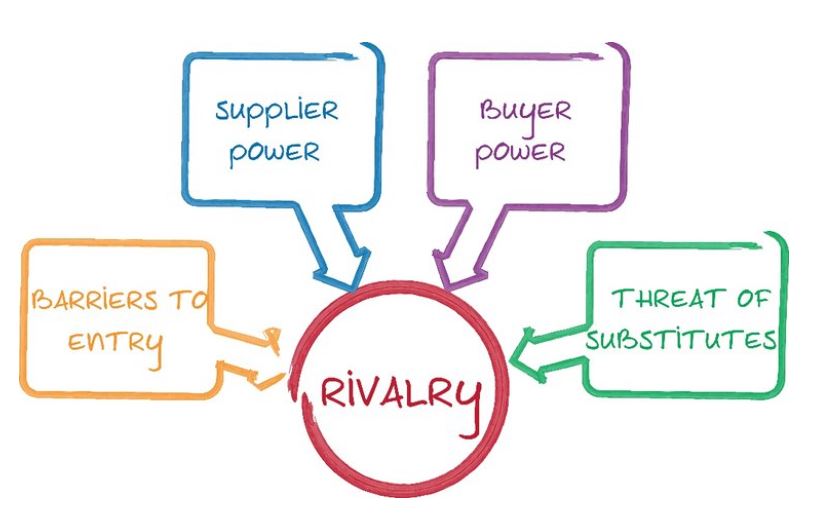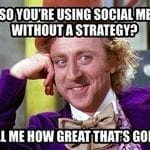Will Agencies End Up Like Supermarkets?
Let’s admit it, supermarkets aren’t a great customer experience. To most of us they represent a grudge purchase and something we have to do, rather than want to do. We hear suppliers don’t get the margins they need and parking and queues are a personal pet hate.
So if we don’t like them, why do we still use them? It’s because they are convenient.
We get it’s easier to use a full service agency too. However like relationships, opting for convenience can mean you’re settling for second best.
Sir Martin Sorrell, former Chairman of global ad agency network WPP, was one of the original architects of full service agencies. He started off in life producing wire shopping baskets which gave him the idea to providing all creative services under the one roof through WPP (which still today stands for Wire & Plastics Products). However only last year WPP reported it’s lowest earnings and Omnicom, its global agency holding competitor, wasn’t doing much better.
The problem with full service agencies is you pay a premium for that privilege. You pay for all the bodies and lights in the building, not just the ones you use, through the overhead and profit multiples that agencies apply to their rates.
Convenience becomes far less convenient when this happens.
Rise of specialist and demise of generalist?
When it comes to special events or occasions, the same ones you could apply to your new brand launch or marketing campaign, I forget convenience and choose the specialists. I want the best and the mainstream often doesn’t stock what I want.
If I want to buy meat I choose a butcher who can advise me on the best cuts, prepare it for me and even tell me where the meat came from. My local wine shop knows what I like and can advise me on new world wines I might not have considered. Same for the baker or fisher monger.
Because each of them isn’t trying to be everything to everyone, I trust them to get it right and serve me better as a customer because they are far more knowledgeable in their dedicated field of expertise. The buying experience is also better than the one I get on checkout #2. And one I’m happy to pay more for.
The same applies to your advertising agency.
JWT, Oglivy, Clemenger, M&C Saatchi and others network agencies like them have worked hard to dispel one-stop shop connotations by buying sister agencies. Despite them being “separate businesses with separate P n’ Ls” the integrated model is still the same. They just use a different configuration.
Think of it like your local supermarket carved up into different areas but still housed inside the same building. Profits have to be pooled from each and paid back to the landlord, or global holding company, that helped fund those acquisitions in the first place.
Power to the periphery, loss to the mainstream?
If you’re in the middle as either agency or client, it’s a tough place.
Take a look at the profitability trends of Tesco and Sainsburys in the UK to see what’s happening there. They used to rule retail but are losing ground to the discounters. The bottom tier is dominated by the likes of Aldi, Lidl who are biting into the middle market of these incumbents whilst the top end plays premium.
Because of this, many agencies pitch themselves as “boutique” and some of them do a very good job of positioning themselves as experts. Others are poor imitations of the real thing using the same model and practices but pricing it at the higher end.
The irony here is also seen when top tier agencies position themselves as business strategists and futurists despite them having done little to disrupt their own antiquated model. Their practices of media commissions, time sheets and rebates have remain relatively unchanged for the last 50 years. Even their agency name originates back in the days when newspapers were their clients who paid “agents” commission to sell advertising space (media commission that still today props up many creative departments).
It feels like clients today are more capable of change than agencies are (see below).
What can ad agencies learn from supermarkets?
Apart from my allergic reaction to the A word (agency), there are two other A words: Amazon and Alibaba.
Both have proven models to drive scale and efficiencies through volume and throughput. They create profit by using lean, operational efficiencies that deliver consumers lower prices using lower margins. The problem is agencies will never be able to do efficiency like Amazon or Alibaba.
Consolidation plays like this signal lower prices for customers and the hope of better dividends for investors. The supermarkets already claim they operate on razor thin margins so it will be interesting to see where this goes.
As costs of goods increase, or in the case of agencies we mean the talent wage bill, the more prices have to go up.
If clients can’t wear that price and want the group or network deal instead, margins suffer and the only way to make money is to sell clients more stuff which takes us right back to the supermarket model again: a basket full of goods at lower prices (also known as a retainer).
Shopping habits are changing.
There is nothing convenient about parking or queuing at supermarkets. Same could be said for inflated hourly rates and clipped tickets in traditional agencies. No one likes them so when they get half the chance, they go elsewhere.
Some of you will you say we’re not comparing apples with apples because creative services or ideas aren’t commodities. I disagree. If creativity or ideas doesn’t sell anything it’s still a commodity by another name.
So here’s the question: whilst clients are adapting to new technologies and changing customer buying behaviour, are agencies doing the same? I’m not convinced because the basic agency model hasn’t changed.
Porters Five Forces Framework.
This useful model shows the competitive pressures agencies are facing from all sides. Companies are substituting external agencies with talent they attract to set up their own in-house agencies like Xero, Red Bull, GoPro, Patagonia and Unilever have. Or they opt to work with a roster of specialists like PepsiCo. Some even use overseas collaboration sites to auction the simple basics like graphic design, website, brand or animation. Even media companies risk biting the hand the feeds by pitching ideas into clients directly using their own creative teams.
Clients are changing even if their agencies aren’t.

- Barriers to Entry – it doesn’t take much to set up shop these days. You need a Mac, a phone and decent internet. I call them garage grads and the likes of Fiverr.com and Freelancer.com are full of them nipping away at the bottom layer.
- Supplier Power – client inertia is nothing like banks, although some agencies might say the turnover of marketing managers makes them the guardians of institutional knowledge. I say no one should know their product or service more than the client. An agency’s knowledge and experience should only build on it using new ideas and perspectives.
- Buyer Power – Dan Pink in his book To Sell is Human, it’s now more caveat emptor(seller beware) rather than caveat venditor (buyer beware) because clients are getting schooled up on rates and scopes of work. You can triple this if you’re dealing with a procurement team who will have benchmarked data at their fingertips.
- Threat of Substitutes – every time a new frustrated disruptreneur enters the market, choice widens and bargaining power for the buyer goes up. The “big 5” accounting firms are onto it too, reaching deep into the data-driven accountability world that agencies can’t compete in. They have the relationship with C suite already. A top table marketing so often never gets near due its inability to prove ROI.
It’s your choice as buyer
More agency overhead and talent acquisition requires more billings and higher hourly rates to cover their standing army. And armies don’t come cheap. Ask Napoleon or The Roman Empire.
The full service traditional agency will continue to have relevance and merit for bigger corporate clients. They will always need the big engine and horsepower for large scopes of work. The supermarket model works well in this context.
If you’re smaller client however, you run this risk of getting lost in the noise and bumped down the priority list to bigger paying clients. As it is in life, one size never fits all.
So what’s the future for agencies?
Like so many other industries, the future is going to be driven by technology that makes everyone a competitor and levels the playing field. This means more choice and control by the buyer, more disruption and greater efficiencies through direct, open marketplaces.
All clients and companies, not just their procurement teams, will become increasingly educated on agency practices allowing them to extract more value. The options are already including smart creative collectives like Communo or Brown&Co.
More flexible, lower overhead models like this can free up budgets to be invested where they work best: in-market. The best talent always back themselves to go it alone so this is where you’ll find them, happy and free of commercial bias.
People will of course criticise us here from promoting the merits of our model and others whilst they promote theirs. That’s ok. Everyone is entitled to their opinion.
In the end, the market always decides anyway. Just like they did with hotels, bookstores, media, the music industry and taxis.
+++
What do you think? Have we got this right or wrong?
If you enjoyed this article, here’s a few more you might like reading too:
NZ Ag: Why Spray And Pray Advertising Doesn’t Work
Why Quantitative Customer Online Surveys Don’t Work
For more articles discussing the future of agencies:
The Future of Ad Agencies





